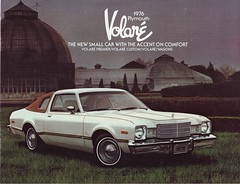8 recalls found. |
DEFECT #1 - SUSPENSION:FRONT:CONTROL ARM:UPPER ARM
Posted on: 1979-10-12
Description
Possible fatigue failure can occur in the frame support plates (front suspension pivot bar support plate) that connects a portion of the front suspension to the vehicle frame on the involved vehicles.
Consequence
Corrective Action
The dealer will inspect support plates for indications of failure and, if necessary, will replace the plates. Additional support brackets will also be installed to reinforce the support plate at the pivot bar attachments.
Notes
Vehicle description: passenger vehicles.system: suspension; frame support plate.consequences of defect: under certain driving conditions, this failure couldaffect vehicle directional control, particularly during heavy brakeapplication. This will result in loss of vehicle control without prior warningand a vehicle accident.
DEFECT #2 - SERVICE BRAKES, HYDRAULIC:POWER ASSIST:VACUUM
Posted on: 1979-10-12
Description
Consequence
Corrective Action
Notes
Chrysler campaign no 217.equipped with power brakes.possibility that thepower brake booster may contain silencer pad that restricts input air duringbrake pedal application due to excessive silencer material density.if thiscondition exists, it could cause braking action delay on rapid pedalapplication and increased stopping distance.(correct by inspecting andreworking suspect booster and removing silencer pad).passenger vehicle.
DEFECT #3 - LATCHES/LOCKS/LINKAGES:HOOD:LATCH
Posted on: 1979-10-12
Description
On the involved vehicles, the hood secondary catch system may be misaligned which may cause the secondary catch to malfunction. Consequently, the hood may not be securely latched.
Consequence
Corrective Action
Dealer will adjust the catch system to fully secure the hood, without charge.
Notes
Vehicle description: passenger vehicles.system: structure; hood secondary latch/striker.consequences of defect: the hood could spring open during vehicle operation,obscuring the drivers view of the road and, possibly, causing an accident.note: if the vehicle was previously recalled for correction of the servicebrake hydraulic system, the secondary hood catch service should also have beencompleted.
DEFECT #4 - FUEL SYSTEM, GASOLINE:CARBURETOR SYSTEM
Posted on: 1979-10-12
Description
On the involved vehicles, the carburetor accelerator pump seal can become distorted due to contact with certain types of gasoline. Normally, when the accelerator pedal is depressed, the accelerator pump is activated to provide additional gasoline required for acceleration. A distorted seal however, may prevent the pump from delivering the proper amount of fuel.
Consequence
Corrective Action
The dealer will replace the carburetor accelerator pump seal with a new seal having improved distortion resistance and will ensure proper adjustment. This will be done free of charge.
Notes
Vehicle description: passenger vehicles.system: fuel; carburetor accelerator pump.consequences of defect: should stalling occur in certain traffic situations, anaccident may result.
DEFECT #5 - EQUIPMENT:OTHER:LABELS
Posted on: 1979-10-12
Description
The involved vehicles may not comply with federal motor vehicle safety standard no. 110, tire selection and rims. The tire pressure placards incorrectly specify the front tire pressure for maximum load conditions. As a result, tires could fail due to overloading.
Consequence
Corrective Action
The owner will be sent the correct placard and has the option of installing it him/herself or having the dealer install it, free of charge.
Notes
Vehicle description: passenger vehicles.system: equipment; tire information placards.consequences of defect: if tire failure occurs, loss of vehicle control and anaccident could occur.note: to eliminate any potential for overloading of the front tires, theinflation pressure of the front tires should be set at 26 psi and maintained atthat level.
DEFECT #6 - SERVICE BRAKES, HYDRAULIC:FOUNDATION COMPONENTS:HOSES, LINES/PIPING, AND FITTINGS
Posted on: 1979-10-12
Description
On the involved vehicles, damage to the front wheel brake hydraulic system could occur due to front wheel brake line tube corrosion. Front wheel brake hoses may become brittle and crack due to prolonged operation in cold temperatures.
Consequence
Corrective Action
The dealer will replace both front hoses if found necessary and in addition, will install a plastic shield between the battery thermo-guard and the tubes to prevent corrosion.
Notes
Vehicle description: passenger vehicles.system: service brakes; steel brake tubes.consequences of defect: loss of front wheel braking capability could resultwhich would increase the vehicle stopping distance and could lead to anaccident.note: illumination of the red warning signal on the instrument panel shouldalert driver that brake malfunction has occurred.
DEFECT #7 - ENGINE AND ENGINE COOLING:EXHAUST SYSTEM:EMISSION CONTROL
Posted on: 1979-10-12
Description
Consequence
Corrective Action
Notes
Chrysler campaign no 209.vehicle equipped with six cylinder engine havingcalifornia emission package.possibility that fuel vapor return line may havebeen misrouted in a manner which allows interference between the line andalternator drive belt.if this condition exists, return line abrasionresulting from interference could result in fuel leakage, with the potentialfor an engine compartment fire.(correct by inspecting and relocatingreturnline to preclude interference).
DEFECT #8 - SEAT BELTS:FRONT:RETRACTOR
Posted on: 1979-10-12
Description
Consequence
Corrective Action
Notes
Chrysler campaign no 211.possibility that the automatic locking lap beltretractor on front outboard seat belt assemblies may intermittently fail toengage in the locked position when the belt is extracted for occupants use.ifthe retractor fails to lock, a belted occupant may not be adequately restrainedduring impact.(correct by inspecting and installing specially developed clipto increase clutch torque output to ensure engagement of the retractor lockingpawl).


